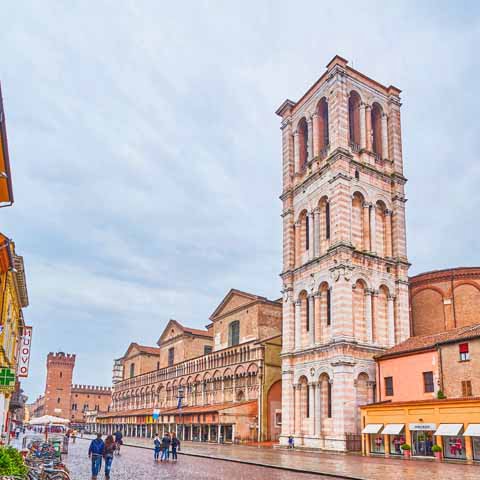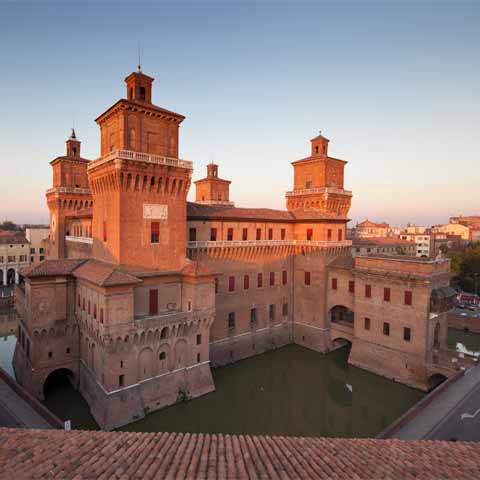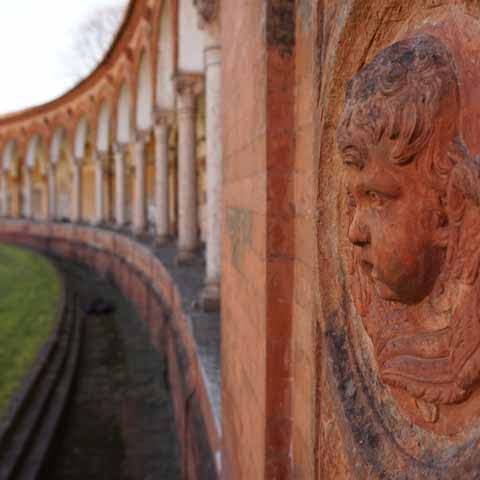Nestled in the Po Valley in the province of the same name, Ferrara is a lovely town in Northern Italy’s Emilia-Romagna region. Home to over 130,000 residents and located a mere stone’s throw north of Bologna and an hour and a half south of Venice, Ferrara is a hidden jewel of Italian culture with far more to appreciate than a mere initial glance would suggest.
Though much of Ferrara’s early history is shrouded in mystery, the first known evidence of the city comes from the eighth century, when it was captured from the Exarchate of Ravenna by King Desiderius. Subsequently, the city truly rose to prominence during the Renaissance era from the fourteenth to the sixteenth century.
Known as the “City of the Renaissance,” Ferrara was the first major Italian city that managed to break away from the Roman style of city planning focused on highlighting major landmarks. Instead, the post-medieval parts of Ferrara were constructed with the concept of an “ideal city” in mind, where all buildings would be arranged in a manner that complimented each other, turning the whole city into a marvel all its own. Visionary architects, most notably the incomparable Biagio Rossetti, would help to make Ferrara into one of the most important examples of Renaissance urban planning, and the developments made then helped give birth to the modern art of city planning. To this day, much of the original layout remains intact.
The result is a city that looks both antiquated and beautiful and yet modernly astounding. The city is full of grand houses, parks, and palazzi that appear simultaneously dignified, due to the masterful techniques of layout and architecture championed in the Renaissance, as well as humble and approachable on account of their simple brickwork construction.
Much of what we see in Ferrara today we owe to the Este family, who ruled as the dukes of Ferrara between the thirteenth and sixteenth centuries. A family of renowned and headstrong Renaissance men, they transformed Ferrara from a simple commune into a center of art and religion to rival more well-known cities such as Florence, Venice, and Genoa. Under the rules of such patrons of the arts as Lionello d’Este, Niccolò II d’Este, and Ercole I d’Este, the city of Ferrara became an international center of culture and development. The Este family ruled Ferrara from the extravagant Castello Estense, or Este Castle at the center of the city, which now stands as Ferrara’s most prominent and famous landmark.
Though often overlooked compared to the usual tourist triangle of Rome, Florence, and Venice, Ferrara offers an abundance of history and culture to discover through its multitude of museums, landmarks, and even its very streets and buildings.
GEOGRAPHY & CLIMATE
Ferrara is located in the Emilia-Romagna region of Italy, characterized by its vast and expansive plains, its numerous canals, and its temperate climate. The city itself sits upon the Po River delta, though there are many more rivers that run through the area, such as the Reno River to the south. Thirty-one miles to the east of the city lies the coast of the Adriatic Sea.
The area sees a great deal of rainfall year-round, though especially in the fall and winter months. Between May and September, however, the climate tends to be warm and pleasant with a greater chance of good weather.
WHEN IN FERRARA
One place you cannot miss when visiting Ferrara is the unparalleled Castello Estense; the center of government and culture during the rule of the Este clan. Here you can admire the history of Ferrara through its most prominent and influential family. The remarkable structure holds apartments that allow a glimpse into Renaissance daily life, a historical dungeon, and a richly decorated chapel, all surrounded by impressive towers and walls, and even a moat.
The Cathedral of San Giorgio is a beautiful representation of Ferrara’s past. Lying in the UNESCO designated historic center of Ferrara, the cathedral boasts incredible architecture and interior design, including astounding, sweeping ceilings painted with incredible frescoes by Renaissance artists. Furthermore, connected to the cathedral is the Museo della Cattedrale, or the Cathedral Museum, where one can learn the history of the cathedral and the other religious buildings of Ferrara.
On the topic of museums, Ferrara has them in abundance. From art galleries to archaeological museums to Jewish wartime history museums, Ferrara has something to interest any lover of art or history. The National Archeological Museum housed in Palazzo Costabili features artifacts from the Etruscan and Ancient Greek Periods, as well as a collection of gold jewelry dating back to the fifth century B.C. Ferrara’s National Art Gallery is located in the unique Palazzo dei Diamanti, which is easily distinguishable thanks to its exterior walls that feature diamond-shaped marble blocks. The gallery itself hosts artwork from the Middle Ages to the eighteenth century with important artists such as Jacopo Bellini and Andrea Mantegna represented.
Those who prefer a more active lifestyle can enjoy a boat trip down the Po River or a walk through the scenic Renaissance city streets, the beautiful Parco Massari, or the Ferrara Botanical Gardens. And for those who wish to escape Ferrara for a day, one can take a quick trip south to Bologna, connected to the town by train for convenience, which offers sights like the Due Torri, Piazza Maggiore, and the Basilica of San Petronio.
Though often overlooked by international travelers, Ferrara is a culturally rich city that’s more than worthy of a visit during a trip to Northern Italy. Thanks to the influence of the Este family, Ferrara is a vibrant Renaissance city with an artistic and architectural heritage that rivals those of Italy’s larger cities.
Travel Guides
The Emilia Romagna Region of Italy
The Cities of Emilia Romagna, Italy










